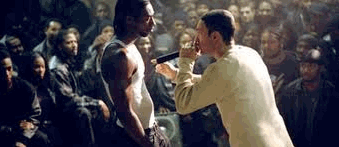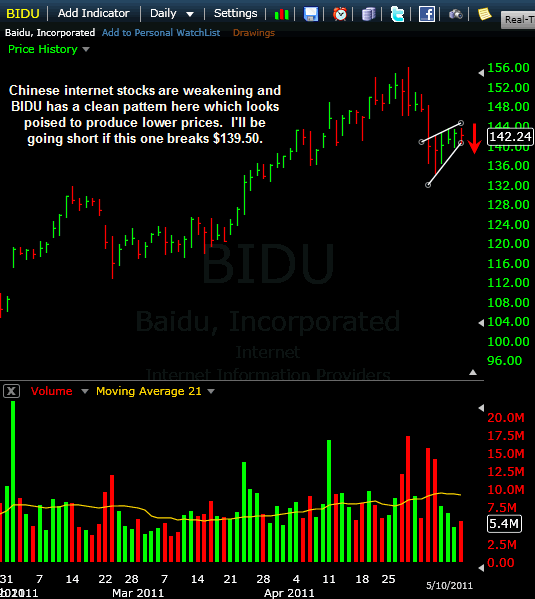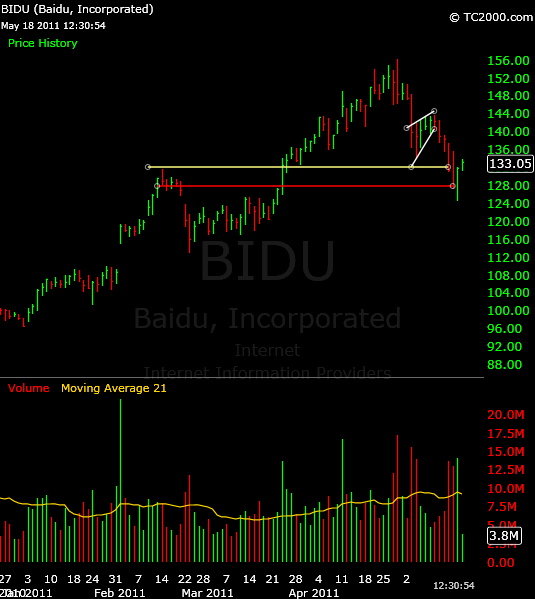 Author Archive for Jeff White
Author Archive for Jeff White
Jeff White is the founder of www.TheStockBandit.com, a nightly newsletter for active traders. He has been trading his own account for over a decade and currently trades full time in Texas.
Walk the Line
May 27, 2011 at 10:41 am
 Trading is all about opportunities. Every day is filled with chances to ride a rally, short a selloff, or sit on the sidelines to protect your capital.
Trading is all about opportunities. Every day is filled with chances to ride a rally, short a selloff, or sit on the sidelines to protect your capital.
But there’s a very fine line to walk between having a fear or respect for what the market can take from you, and having the boldness and confidence to take a risk and get paid.
There are several keys to walking that line successfully, such as:
- Having the necessary capital to participate.
- Building and maintaining sufficient skills, methodology, and a game plan that produces consistency.
- Discipline and readiness to move swiftly when it’s time to act.
- The mental restraint not to let your mind race too far ahead.
That last bullet is arguably more important than the others (although each are necessary), so let’s dig a bit deeper into it. When I say don’t let your mind race too far ahead, I’m not referring to the productive foresight of anticipating a move – that’s fine. Rather, I’m referring to thinking habits whereby you’re focused on things which are not a present-tense reality.
These are the thoughts that have you counting on a gain before you’ve actually booked it, or fearfully racing for the exit at the first sign of your trade’s hesitation. They’re destructive and damaging thought patterns, and they aren’t “on the line” we want to be walking.
In your trading, do you allow your mind to get ahead? Are you able to stay objective? It’s an issue of self-control, and it absolutely impacts your trading results.
I’d love to give you a simple 3-step process to entirely eliminate any lack of discipline in your thought process, but the truth is it takes work. It can’t be rushed. Even your thought patterns are based upon habit.
Final word: commit to making some good decisions every day – no matter how small – knowing it’ll keep you right in the sweet spot between respecting the market and confident execution.
Trade Like a Bandit!
Jeff White
Producer of The Bandit Broadcast
Flip Your Fears
May 26, 2011 at 9:17 am

“Look…if you had one shot, or one opportunity … to seize everything you ever wanted in one moment…would you capture it, or just let it slip?”
Pivot Points to Watch 5-25-2011
May 25, 2011 at 12:42 pm
Working the charts today, I’m seeing a ton of stocks sitting just beneath descending trend lines, all of which are potential pivots for bullish moves.
In the video below, I take 5 minutes to run through a couple dozen setups to keep an eye on, highlighting the setups and pivot levels to take note of.
Thanks for joining me for today’s video, until next time…
Trade Like a Bandit!
Jeff White
Producer of The Bandit Broadcast
Not a Pattern Day Trader?
May 24, 2011 at 10:19 am
The phrase ‘Pattern Day Trader’ has this negative connotation to it which scares a lot of people unnecessarily. It conjures up images of high risk or compulsive behavior, neither of which are entirely accurate.
Many traders have asked me about having the Pattern Day Trader designation out of concern that it puts them in the same light as ‘perpetual liar,’ or ‘drug addict’ or any of the corrupt individuals found on the no-fly list.
Nonsense! Don’t get spooked by a label.
 The Pattern Day Trader designation is simply a category for an account, and therefore doesn’t mean you have any sort of a repetitive disorder!
The Pattern Day Trader designation is simply a category for an account, and therefore doesn’t mean you have any sort of a repetitive disorder!
What It Is
The SEC implemented this classification for accounts, and brokers are required to comply. The restrictions imposed on those without the designation are not a plot against you – your broker is simply enforcing what they’re required to do. Supposedly, the SEC put the PDT rules into effect to protect those with smaller accounts from the ‘high risks’ associated with day trading (as opposed to those ‘other’ high risks found in longer-term ‘investments’ or crossing the street at a busy intersection).
* Personally, I think attempting to pick the next MSFT and holding
hoping for decades it works out is higher risk than the astute day
trader who’s continually limiting his losses, but I digress…
The Pattern Day Trader distinction carries with it two requirements, which are that the account is a margin account, and that it maintains a $25,000 equity balance. Once those are met, you’re free to trade as often as you want, as well as have the benefit of 4:1 intraday margin at your disposal – nice for those who know how to use it.
Those without this account designation, however, have some restrictions. Primarily, they’re unable to make 4 or more round-trip trades in a 5-day period. That really cramps the style of the would-be active trader who has an account below the threshold, and it’s easy to argue that there’s HUGE risk in having your account frozen when the market is on the move.
Get Creative
If you’re one of the traders currently limited in your activity by the Pattern Day Trader restrictions, take heart. You have choices.
The most obvious is to fund your account enough to bring it past the threshold. That’s not an option for everyone, but arguably, even if you didn’t intend to fully utilize the capacity of the account (or day trading buying power which comes along with it), you’re at least free to trade as you see fit with no restrictions.
Supposing that’s not a viable option, there are others, so let’s explore a couple.
* Focus on longer timeframes. There’s nothing that says you can’t trade – only that you can’t trade very frequently! That shouldn’t prevent you from zooming out a bit on your timeframe from multi-hour trades to multi-day trades, ie: swing trading. That approach certainly has benefits – not only does it allow you to sidestep much of the intraday noise and seek out larger moves, but it will of course mean fewer transactions. The lack of churning will also cut down on commissions, which is a nice fringe benefit.
* Consider trading futures. Futures are leveraged, but for the e-mini Nasdaq 100 or S&P 500 futures contracts, margin requirements are pretty low. Futures are also not restricted to the Pattern Day Trader, so activity isn’t limited.
* Look at your options. While the Pattern Day Trader rule still applies to options, one element which many don’t consider is the turnover of capital within smaller accounts to make room for a new equity position. For example, if you’re holding a stock which you don’t necessarily want to dump, yet see another you’d rather have, most likely you’ll exit the old in favor of the new (supposing your account doesn’t have enough equity to hold them both). With options, however, smaller amounts of capital are needed to control an equity position, thus allowing you to have positions in both. Options of course expire, and there are other risk factors to consider if you have no experience trading them, but they do offer an alternative to an either-or equity stance.
The bottom line is that even if you’ve been slapped with the Pattern Day Trader designation, there are ways to be effective without simply buying and hoping. As in many endeavors, a little creativity goes a long way in trading.
Trade Like a Bandit!
Jeff White
Producer of The Bandit Broadcast
Are you following me on Twitter yet?
Premature Evacuation from Trades
May 23, 2011 at 10:10 am
 All of us have the occasional urge to jump ship early from a trade, but when is it the right time and how should that be done?
All of us have the occasional urge to jump ship early from a trade, but when is it the right time and how should that be done?
Let’s take a look at a conversation I recently had with a trader I was helping…
Hey Jeff,
I’m long ***, as it just looked like a nice setup. I went long 4 days ago, but it is behaving horribly. Currently I don’t see any pattern and would not make this trade now, but it is only halfway to my stop loss. I am unsure what to do. How do you approach trades you aren’t convinced of anymore, but have not been stopped out of?
Also, one of the mantras I read often is “cut losses short, let winners ride.” I am wondering how to interpret this “cut losses?” I find myself thinking, “I am not convinced in this trade anymore, but maybe it will turn around, it’s just half a position left to lose.” When my analysis of the situation shifts, and I wouldn’t take this trade anymore as of today, do I abandon my original plan and exit immediately or should I stay with the trade?
C.
==
Here’s what I told him…
C,
Let me start off by addressing the “cut losses short” question. I don’t have all the answers, but I can tell you that for me, cutting losses means having an exit plan on the downside with defined risks. We will all be wrong at times, but staying wrong is different – don’t stay wrong! Limit your losses so that they can be overcome with reasonable winning trades. Don’t dig a hole so deep you need a miracle to get out – that’s cutting your losses short.
Now let’s discuss early exits on trades like this where your conviction level has changed…
Occasionally you’ll find trades like this which don’t completely fail (stop you out), yet don’t work either (move to your targets). Instead, they just begin to stagnate and enter into a trading range where your funds are tied up. It can be a bit frustrating, simply because you’re left in limbo, wondering if the trade is in the process of failing or working. Each new red or green bar feels like the start of something meaningful, but they’re followed by the opposing color and you soon realize that price is simply showing indecision.
A key consideration to make when this happens is whether the character of the stock has changed. Stated otherwise, do you have a good reason to now lack conviction, or is it merely a mood shift for you?
A slow-moving trade is far different than one which may have just experienced an important technical event…
- Just because a trade isn’t developing quite as quickly as you would have wanted doesn’t mean it’s destined for failure.
- The stock may be building a new pattern which you simply haven’t identified yet.
- When I find myself in a trade which is starting to bore me, I know I’m overanalyzing when I start looking for signals which aren’t there.
- If I’m positioned in accordance with the overall market (ie: long in a market uptrend), and if my trading capacity isn’t restricted because of this position (I don’t need to free up capital), then what I need to do is stay with the trade until a technical reason prompts an exit. I likely need to stay patient, as this is still a trade which can pay me.
On the other hand, there are times when a premature exit may be warranted…
- When the stock has just seen a change in character as measured by a technical event (high-volume reversal, for example), an adjustment may be called for.
- If your trading funds are limited and you’d rather shift into a better idea, then you might consider closing out the trade in favor of another with more promise.
- When you find yourself positioned in opposition to the prevailing market trend (ie: long in a market downtrend), then you have grounds to at least lighten up. That can be done either by reducing your position while maintaining your original stop & target parameters for the trade, or by tightening both your risk and objective.
What else could help C. in this situation?
Trade Like a Bandit!
Jeff White
Producer of The Bandit Broadcast
Are you following me on Twitter yet?
Choose Your Discomfort
May 19, 2011 at 9:52 am
 Trading is not easy.
Trading is not easy.
There…I said it. As if you didn’t already know.
It can be simple, but that’s different. When you’re trading well, it might feel easy, but when the tough stretches arrive again (and they will), you’ll be reminded that it’s hard. As they say, “if it were easy…”
Contrary to what most traders think, the hard part of trading isn’t being right or wrong. Each of us will find ourselves in winning trades and losing trades at times – even random entries can produce (at least temporary) profits. Discomfort is the hard part.
Discomfort in trading can be tied to either profits or losses.
For example…
Our minds seem hardwired to shun (perceived) failure, so some traders struggle in a big way to close out a losing position and instead spend waste time hoping for a turnaround which may or may not ever happen. It’s uncomfortable for them to admit defeat and accept a small loss, so they usually pay big to try and avoid that.
Our minds can also have recency bias, so after a string of losses, it’s tempting to book a winner – no matter how small – just to stop the bleeding and have a taste of success again. It can be uncomfortable to let open profits ride when you’re clearly on the correct side of a trade – what if you give them back?! You need this winner, right? That often leads to booking smaller gains as compared to what you were on track to get paid, and that adds up big over the course of your month, or your year, or your career.
Discomfort can also be tied to our preferred trading timeframe.
Some can’t stand the erratic price action found on the intraday charts, and they tend to respond with late or forced entries when day trading. They get spooked out of good trades, opting instead to focus on the most recent 5-minute bar rather than the overall direction that’s taking place.
Others can’t stand to give a stock an appropriate amount of wiggle room when swing trading, so they choke off what would be a good trade in favor of a stop that’s too tight. Instead of positioning themselves smaller in order to weather the short-term shake-outs, they essentially overtrade by reacting to insignificant moves within the context of a bigger trend. Profits aren’t allowed to pile up, and their skittish approach keeps them frustrated by the big moves they were once a part of but missed out on.
Here’s my point:
Risk involves discomfort, so if you’re constantly avoiding discomfort, you’re avoiding risk – and by definition, risk must be taken in order to profit in the markets. The key is to manage that risk appropriately, which also means managing your discomfort appropriately.
There’s no getting around discomfort in trading. Everyone has it, regardless of directional bias or timeframe preference or the market being traded.
Either you’re uncomfortable with the results you’re getting (e.g. overtrading, not sticking with good trades, staying too long in poor trades), or you’re going to face some discomfort while denying yourself as you stay with a good position. That’s going to include enduring pullbacks, watching some profits evaporate, and being patient while waiting for an acceleration move to occur.
In an instant-gratification society like ours, it’s no wonder most traders fail. Have the courage to choose your discomfort ahead of time, so that by expecting it and mentally rehearsing what you’ll likely face, you’ll in turn be able to respond with good decisions.
Trade Like a Bandit!
Jeff White
Producer of The Bandit Broadcast
Are you following me on Twitter yet?
Trade Review: BIDU Breakdown
May 18, 2011 at 11:56 am
One setup I recently had success with was found in BIDU. Although the money’s been made on this trade, there are still some lessons we can take away, so let’s take a closer look at the trade as it evolved and see what we can learn from it.
The entire Chinese internet stock group had been weakening of late, with names like SOHU, SINA, NTES, and others beginning to struggle. This followed months of leadership, as these stocks made big upside runs by building bases upon bases. The momentum shifted a few weeks ago, and in every case these stocks topped prior to the market’s pullback. (That’s why they call them leaders).
BIDU did the same thing, having peaked in late-April ahead of the major averages like the NASDAQ. Once the overall market began to pull in, these stocks accelerated to the downside, providing further evidence of an important change of character. Having become oversold, they rebounded, but in a lazy fashion. This set up quite a few bearish patterns, with the rising wedge being found in BIDU. I highlighted this pattern for premium readers on the main site, looking to short BIDU upon a break of the lower trend line at $139.50.
BIDU broke that rising trend line, a day after its counterparts NTES & SINA. That offered not only a clean entry for a short sale, but also a stock which had potential to play catch-up on the downside.
I set a pair of targets for booking profits at $132 (yellow line in chart below) and $127.50 (red line on chart below), respectively. Target 1 was reached on day 3 of the breakdown, which was just slightly ahead of the 2/14 high in case it were to be tested. Target 2 was reached on day 4, and that level corresponded with the lower end of the same mid-February congestion zone.
While this stock eventually overshot my $12 per share profit target, it became oversold. Anytime a stock moves too far, too fast, it’s time to watch for a snapback. BIDU has done that in the past 2 sessions, but remains technically damaged. Here’s a current look:
This stock and the others in the group are currently bouncing from their lows, but they remain in a bearish series of lower relative highs on their daily charts. That is to say this bounce may get sold into again, so although this short sale is long since over, we have no evidence yet to support a lasting trend change. Until we do, these are stocks to watch for new short-sided entries to emerge.
A few takeaways:
First, clean patterns are the place to focus. They make it simpler for me to recognize when to be IN a trade, and perhaps most importantly, when to be OUT of the trade. Tighter, more well-defined patterns help me be decisive, and in this game, that’s huge.
Second, stay on top of the sectors. While it’s a bit harder these days to play follow-the-leader when it comes to sector moves, it can still be done with success. Take note of which groups are shaping up for advances or declines, and work the charts for favorable candidates.
Third, when you get your move, ring the register. Greed could have kept me in this trade for a little bigger move, but it also could have kept me in too long, leaving me now to wonder what to do on the current bounce. Blend the info you get by looking left on the chart along with the pattern projection to come up with an exit strategy. Then stick to it!
Fourth, (and this goes hand-in-hand with the previous note), sharper moves are more prone to reversal. When your targets are in sight (or already hit) and the move is getting a bit stretched, expect the rubber band to snap back at least part way. Tighten your stops, book gains, and generally start expecting an imminent exit. Pigs truly do get slaughtered.
Here’s to your next trade, whether a winner or loser, and your commitment to take from it what you can – whether it be profits, a lesson, or both.
Trade Like a Bandit!
Jeff White
Producer of The Bandit Broadcast
Are you following me on Twitter yet?







